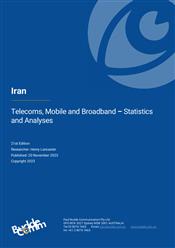Iran Telecoms Market Report
Telecoms, Mobile and Broadband - Statistics and Analyses

Last updated: 20 Nov 2023 Update History
Report Status: Current
Report Pages: 107
Analyst: Henry Lancaster
Iran aiming to cover 20 million premises with a fibre broadband service by end-2025
Iran’s telecom infrastructure continues to suffer from sanctions, which over the last few years has prevented the import of equipment and devices. This has encouraged widespread smuggling, and consequently the loss of tax revenue.
The government has made use of its wide but opaque powers to enforce digital repression in various forms. It has imposed network blackouts, restricted the range of mobile apps available, compelled the telecom regulator to monitor internet traffic and report the activities of protestors, activists and others suspected of opposing the government. All the while, it has expanded the reach of its national intranet, which offers only government-approved Islamic content.
Operators have invested in broadening the reach of their LTE networks, which has increased network capacity and improved the quality of mobile broadband services. There has also been investment in 5G, though the development of this sector has been hampered by the paucity of available spectrum. To address this, the government planned imminently to release spectrum in the 3.7-3.8GHz range for 5G.
From a broad perspective, Iran offers significant opportunities for growth in the telecoms sector. The country has one of the largest populations in the Middle East, and there is a high proportion of youthful, tech savvy users having considerable demand for both fixed and mobile telecom services. However, the free use of such services is hampered by government control and regulatory monitoring, conditions which severely limit the market’s potential for growth and innovation.
Recent developments:
- Government aiming to cover ten million premises with a fibre broadband service by March 2024 and 20 million by end-2025.
- European Union sanctions Iran’s telecom regulator for implementing laws on intercepting traffic carried by the country’s telcos, and for filtering internet content through spyware.
- Government again extends the 6th Development Plan as it reviews the 7th Plan through to 2028.
- Iran’s closed national intranet makes progress.
- MTN announces plan to hold an IPO during 2024.
- Shatel Mobile reports having signed up one million mobile subscribers as of September 2023.
- Spectrum in the 3.7-3.8GHz range to be released for 5G services.
- Regulator predicts that the number 5G base stations will increase to 1,200 by March 2024 and to about 4,000 by March 2025.
- Report update includes telcos’ operating data to Q3 2023, updated Telecom Maturity Index charts and analyses, assessment of the global impact of the pandemic on the telecoms sector, recent market developments.
Companies mentioned in this report include:
Telecommunication Company of Iran (TCI), Mobile Communications Iran (MCI), MTN Irancell, Tamin Telecom (Rightel)
Related Reports
- Middle East - Mobile Network Operators and MVNOs
- Middle East - Mobile Infrastructure and Mobile Broadband
- Middle East - Fixed Broadband Market (Bundle 11 reports 2022-2023)
- Saudi Arabia - Telecoms, Mobile and Broadband - Statistics and Analyses
- Kuwait - Telecoms, Mobile and Broadband - Statistics and Analyses
- Yemen - Telecoms, Mobile and Broadband - Statistics and Analyses
- Lebanon - Telecoms, Mobile and Broadband - Statistics and Analyses
- Qatar - Telecoms, Mobile and Broadband - Statistics and Analyses
Share this Report
TMT Intelligence
A platform to scale your intelligence tasks
Monitor critical insights with our AI-powered Market Intelligence Platform gathering and analyzing intelligence in real time. With AI trained to spot emerging trends and detect new strategic opportunities, our clients use TMT Intelligence to accelerate their growth.
If you want to know more about it, please see:
Research Methodology
BuddeComm's strategic business reports contain a combination of both primary and secondary research statistics, analyses written by our senior analysts supported by a network of experts, industry contacts and researchers from around the world as well as our own scenario forecasts.
For more details, please see:
More than 4,000 customers from 140 countries utilise BuddeComm Research
Are you interested in BuddeComm's Custom Research Service?
Hot Topics
News & Views
Have the latest telecommunications industry news delivered to your inbox by subscribing to BuddeComm's weekly newsletter.